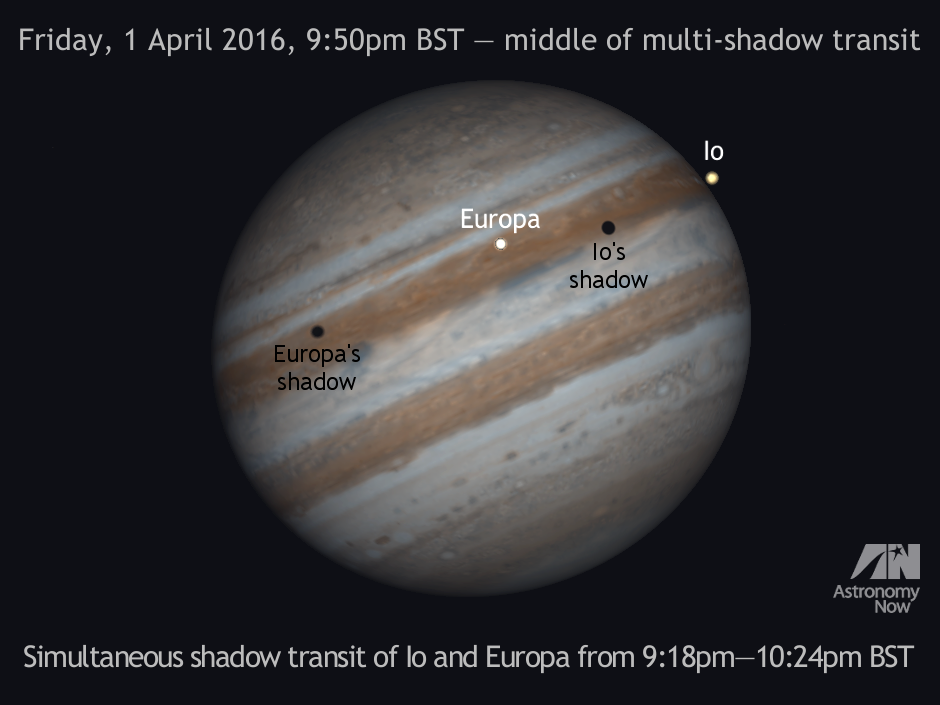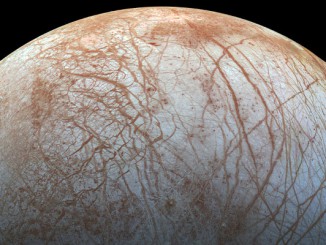
Readily observable phenomena of Jupiter’s four large Galilean moons Io, Europa, Ganymede and Callisto continue as their orbital motion causes them to play cat and mouse with their parent planet. If you have a quality telescope of 3-inch (7.6cm) aperture or larger that’s capable of handling magnifications of 100x or more on nights of good seeing, then you too can see all of the following events from the British Isles (weather permitting, of course).
Multi-shadow transits
The shadows of Io and Europa will appear simultaneously on the Jovian cloud tops from 9:18pm to 10:24pm BST on Friday, 1 April. The image at the top of the page simulates the telescope view mid-event. As dusk fades to dark this night, Io’s shadow will already be on Jupiter’s disc and once the double shadow transit is over, Europa’s shadow will remain on the face of its parent planet until 12:05am BST on 2 April.
One week later, another double shadow transit of Io and Europa occurs on the night of 8/9 April. Io’s shadow begins to cross the face of Jupiter at 10:02pm on Friday the 8th, joined by that of Europa at 11:55pm BST. The pair of shadows may be seen on Jupiter until Io’s glides off the Jovian disc at 12:16am BST on Saturday the 9th.
The Great Red Spot is easiest to see when it crosses the imaginary line joining Jupiter’s north and south poles that passes through the centre of the planet’s disc. At such times we say that the GRS is ‘in transit’. For observers in the British Isles, conveniently observable transits of the Great Red Spot occur during April on the following dates and BST times: 2 (12:59am & 8:51pm), 4 (2:38am & 10:29pm), 7 (12:08am), 9 (1:46am & 9:37pm), 11 (11:15pm), 14 (12:54am & 8:45pm), 16 (2:32am & 10:23pm), 19 (12:02am), 21 (1:40am & 9:31pm), 23 (11:10pm), 26 (12:48am), 28 (2:27am & 10:18pm) and 30 (11:57pm).
Other Galilean moon phenomena
In addition to shadow transits, one may also occasionally observe Io, Europa, Ganymede and Callisto being hidden by Jupiter’s disc (an event known as an occultation), or pass into the planet’s shadow (an eclipse). Here is a quick summary of forthcoming shadow transit, occultation and eclipse events visible from the UK:
You may also obtain these predictions for yourself for any given date or location in the world through our interactive online Almanac.
Note that the Almanac’s predictions of Jovian phenomena use 24-hour Universal Time (UT) — a global time reference based on the rotation of the Earth loosely synonymous with Greenwich Mean Time (GMT) that is one hour behind British Summer Time (BST) currently in force.
Always ensure that the Almanac’s Daylight Savings Time check-box is ticked if applicable to your date, time and location. For help using the Almanac, see this article.
Inside the magazine
Find out all you need to know about observing Jupiter and the other solar system bodies in the night sky in the April 2016 edition of Astronomy Now.
Never miss an issue by subscribing to the UK’s biggest astronomy magazine. Also available for iPad/iPhone and Android devices.




